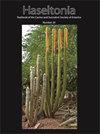Why is the Shaw's Agave (Agave shawii subsp. Shawii) Not Reproducing? Investigating a Rare Species' Pollination and Germination in a Fragmented Urban Park
IF 0.4
4区 生物学
Q2 PLANT SCIENCES
引用次数: 0
Abstract
Abstract: Shaw's Agave (Agave shawii subsp. shawii) is a rare plant found in only a handful of occurrences within the extreme southwestern corner of the USA in a highly urbanized region. Seedling recruitment of Shaw's Agave in California is visibly low, and viable seed production appears to have been very low in recent years, and has been identified as a primary threat to the persistence of these populations. We performed pollination trials, seed germination studies, and inventoried floral visitors and potential pollinators (including the collection of invertebrates) to determine if pollination and/or germination failure is limiting reproduction. We placed bat detectors and camera traps near blooming agaves, and observed bird and insect visitation to the flowers. Pollination treatments included hand pollination with cross-individual and selfing trials. Our results found a low amount of seed produced per fruit across the pollination trials. Seedling herbivory was also very high (85% and 100%) in the two treatments. The combination of low seed set and high herbivory may help explain the lack of recruitment observed at multiple sites in recent years. No nectar feeding bats utilized the Shaw's agave in our study area. The only significant insect visiting flowers was the honey bee (Apis mellifera), which gathered nectar without touching the anthers. Hummingbird species were also frequent visitors but generally avoided touching the agave anthers. Only the Hooded Oriole (Icterus cucullatus), a migratory bird, appeared to regularly visit flowers for their nectar, while standing on the flowers and brushing against the anthers, potentially providing some pollination but only for plants blooming during the period the oriole is present in the region. Seedling predation was significant, and poses a considerable threat to this population. Further research into seed set and pollination treatments is recommended.为什么萧氏龙舌兰属(龙舌兰属)?Shawii)不繁殖?破碎化城市公园中珍稀物种授粉与萌发的研究
摘要:肖氏龙舌兰(Agave shawii subsp.);是一种罕见的植物,只在美国高度城市化地区的西南角出现。加州龙舌兰的幼苗招募明显很低,近年来可行的种子产量似乎很低,这已被确定为这些种群持续存在的主要威胁。我们进行了授粉试验、种子萌发研究,并对访花者和潜在传粉者(包括无脊椎动物的收集)进行了调查,以确定授粉和/或发芽失败是否会限制繁殖。我们在盛开的龙舌兰附近放置了蝙蝠探测器和相机陷阱,并观察鸟类和昆虫对花朵的访问。授粉处理包括手传粉、交叉授粉和自交授粉。我们的研究结果发现,在授粉试验中,每个水果产生的种子量很低。两种处理的幼苗食草性也很高(85%和100%)。低结实率和高食草性的结合可能有助于解释近年来在多个地点观察到的缺乏招募。在我们的研究区域,没有吃花蜜的蝙蝠使用肖氏龙舌兰。唯一到访花朵的重要昆虫是蜜蜂(Apis mellifera),它们不用接触花药就能采集花蜜。蜂鸟也是龙舌兰花药的常客,但通常避免接触龙舌兰花药。只有冠黄鹂(Icterus cucullatus),一种候鸟,似乎定期访问花蜜,站在花上,蹭花药,潜在地提供一些授粉,但只对在黄鹂出现期间开花的植物在该地区。苗木捕食显著,对该种群构成了相当大的威胁。建议进一步研究结实率和授粉处理。
本文章由计算机程序翻译,如有差异,请以英文原文为准。
求助全文
约1分钟内获得全文
求助全文
来源期刊

Haseltonia
生物-植物科学
CiteScore
3.00
自引率
6.70%
发文量
11
审稿时长
>12 weeks
期刊介绍:
Haseltonia, Yearbook of the Cactus and Succulent Society of America, is published in full color and features peer-reviewed articles about all aspects of cacti, succulents and their environs. Topics include current research and conservation reports, new species descriptions and lengthy taxonomic revisions, historical and biographical notes, chemical and cytological studies, evolutionary biology and ethnobotanical reports, propagation and pest control methods, and pollinator studies. Serious students of the world''s succulent flora, botanists, taxonomists, researchers and horticulturalists will all find Haseltonia a valuable addition to their book collection.
 求助内容:
求助内容: 应助结果提醒方式:
应助结果提醒方式:


